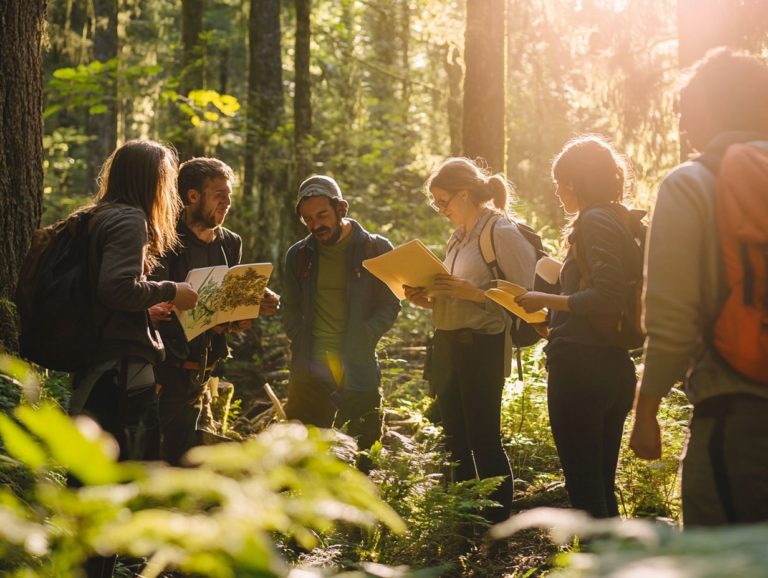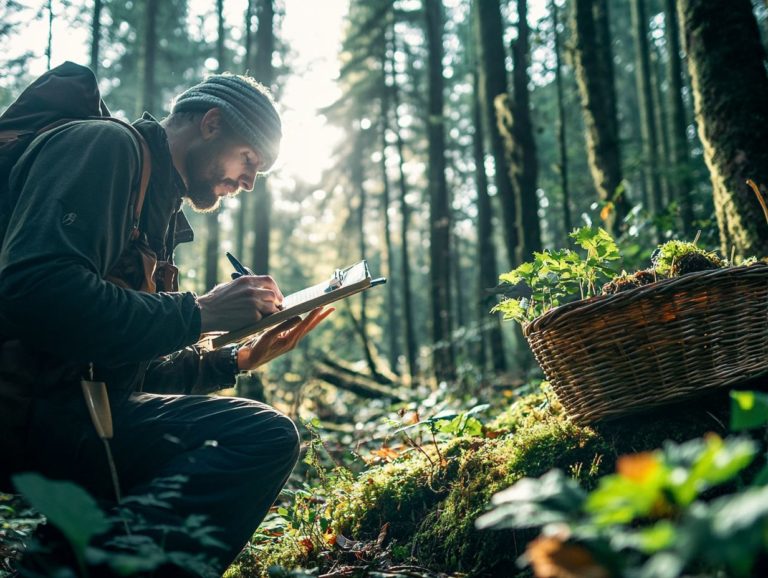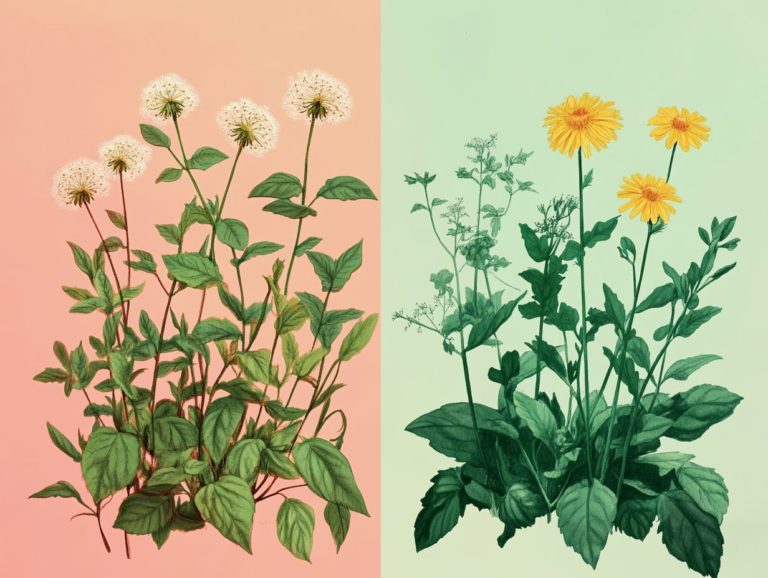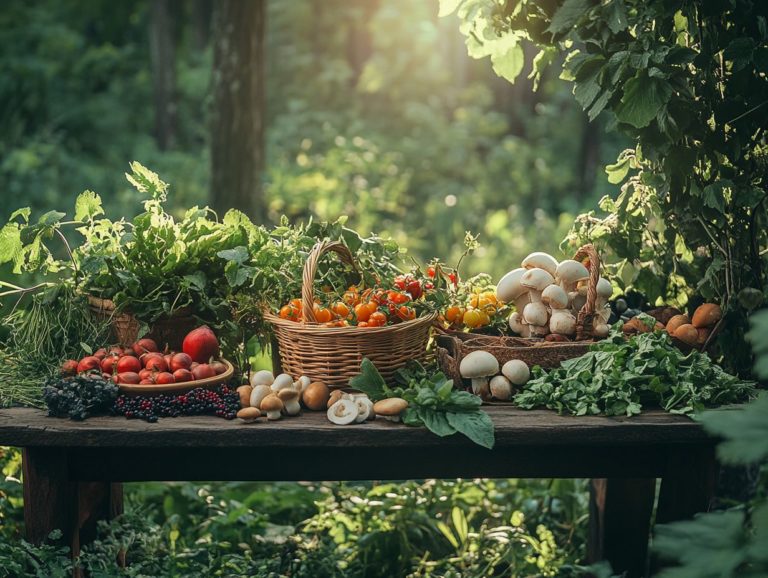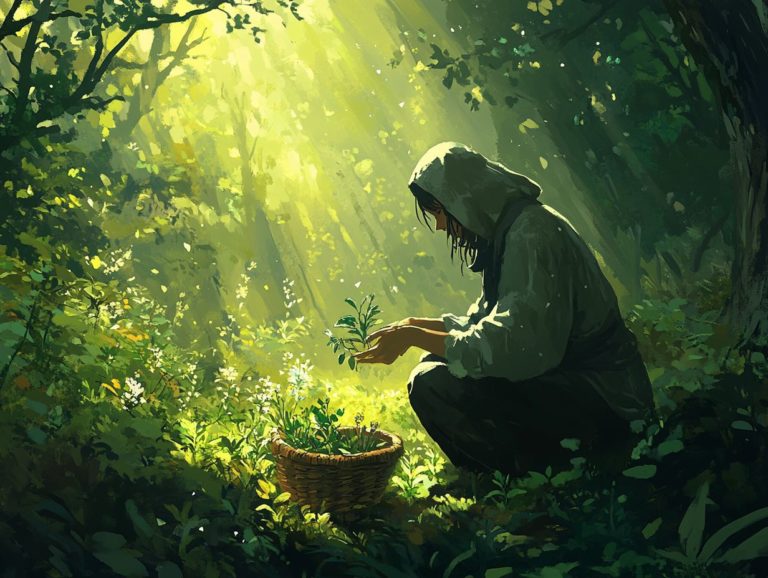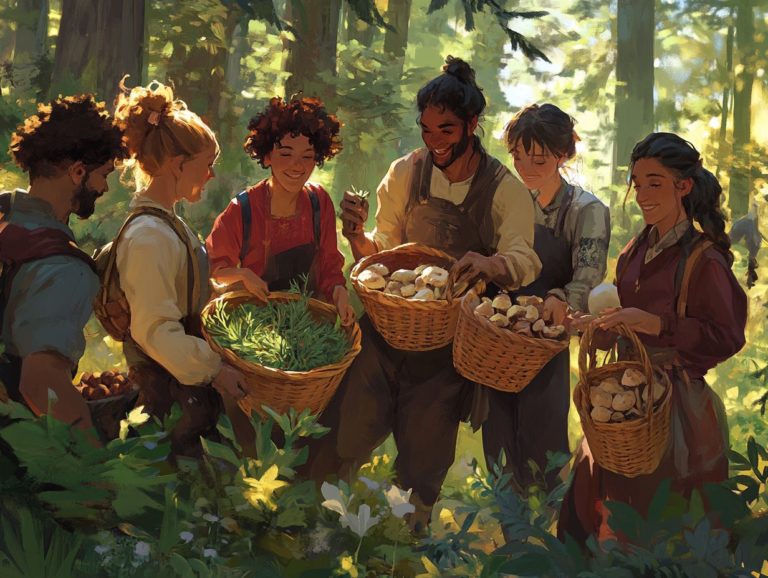7 Essential Foraging Skills for Everyone
Foraging transcends mere trend; it serves as a profound journey into nature, connecting you with the land and your food sources. Discover various wild plants and their incredible benefits.
Whether you re a seasoned enthusiast or just starting out, honing essential skills like plant identification and safety will elevate your foraging experience.
This guide will walk you through identifying edible plants, understanding seasonal availability, and safely harvesting. You ll also learn about ethical foraging practices and how to store and cook your wild food finds.
You ll learn how foraging helps the environment and receive valuable tips to navigate common pitfalls. Start your adventure today as we explore the remarkable benefits of foraging for you and the planet.
Contents
- Key Takeaways:
- 1. Identifying Edible Plants
- 2. Understanding Seasonal Availability
- 3. Knowing How to Safely Harvest
- 4. Properly Storing and Preserving Foraged Foods
- 5. Using Foraged Foods in Cooking
- 6. Recognizing Poisonous Plants
- 7. Respecting the Environment and Wildlife
- How Can Foraging Benefit the Environment?
- What Are Some Common Mistakes to Avoid When Foraging?
- What Are Some Tools and Equipment Needed for Foraging?
- How Can Foraging Be Incorporated into a Sustainable Lifestyle?
- What Are Some Common Foraged Foods and Their Nutritional Benefits?
- How Can Foraging Connect People to Nature and Their Local Community?
- Frequently Asked Questions
- What are the 7 essential foraging skills for everyone?
- Why is plant identification an important foraging skill?
- How does tracking play a role in foraging?
- What is the importance of knowing how to build a fire when foraging?
- Why is shelter building an important foraging skill?
- How does water sourcing factor into foraging?
- Why is food preservation an essential foraging skill?
Key Takeaways:
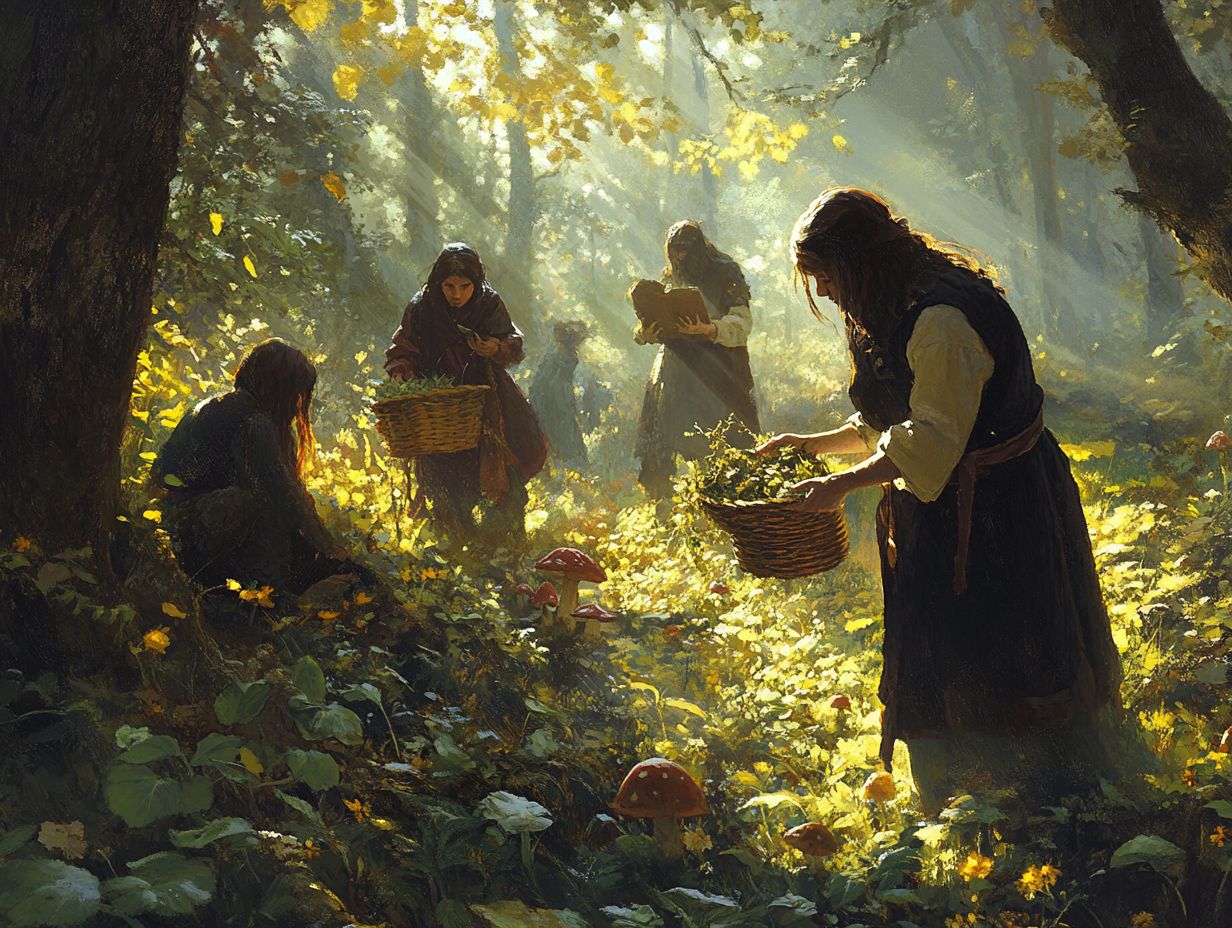
- Always properly identify and safely harvest edible plants. Use local guides and foraging resources.
- Understand seasonal availability and proper storage techniques. These are crucial for successful foraging.
- Foraging promotes a sustainable lifestyle and connects you to nature. It provides nutritional benefits and enhances community learning.
1. Identifying Edible Plants
Identifying edible plants is an essential skill for foragers. It opens the door to a diverse range of wild food options, including wild herbs and edible mushrooms. To enhance your foraging skills, check out the top 5 foraging techniques for beginners.
This mastery transforms your foraging journey and enhances your skills in outdoor exploration and wildcrafting. By learning how to develop your own foraging techniques and recognizing local flora, like dandelions and elderberries, you can enjoy both nutritional benefits and sustainable practices.
To delve into edible plants, you need keen observation and an understanding of their growing environments. Engaging with local guides and attending identification classes can significantly enhance your experience.
These classes often include field trips to identify wild edibles like nettles and ramps. Such experiences build confidence and appreciation for the roles these plants play in local ecosystems.
2. Understanding Seasonal Availability
Understanding seasonal availability is essential for foraging success. It helps you know when to seek various edible plants and wild food sources.
In spring, you ll find wild edibles like ramps, dandelions, and fiddlehead ferns. As summer arrives, berry bushes burst with delightful options like blackberries and blueberries.
When fall rolls around, look for nutrient-rich nuts like acorns and chestnuts. In winter, seasoned foragers search for unique finds like pine needles and wild mushrooms to brew soothing teas.
Each season presents its own challenges and rewards. To enhance your experience, consider using foraging techniques for beginners to thrive in the great outdoors.
3. Knowing How to Safely Harvest
Understanding how to safely harvest wild plants while following established safety guidelines is crucial for anyone who goes foraging. It not only safeguards your personal well-being but also supports ethical practices that protect local ecosystems and biodiversity.
As you go foraging, take the time to familiarize yourself with the local flora. This knowledge enables you to confidently identify edible plants, helping you avoid the pitfalls of harvesting toxic varieties. It’s essential to adhere to sustainability guidelines, such as limiting your harvest to no more than one-third of a plant population while leaving enough roots and seeds for regeneration. By being mindful of the environment and connecting with local foraging communities, you can significantly reduce your impact on these natural habitats.
Using tools that won’t damage the soil and surrounding vegetation is another way to help preserve these delicate ecosystems, which is a key aspect of foraging ethics. Connecting with local foraging communities can provide valuable insights into responsible harvesting and ongoing conservation efforts.
4. Properly Storing and Preserving Foraged Foods
Storing and preserving foraged foods is a game changer for enjoying nature’s bounty! It maximizes their shelf life and maintains their nutritional value, allowing you to savor the fruits of your labor long after the harvesting season has passed and enjoy wild foods year-round.
Among the various methods at your disposal, drying emerges as a favored choice for many wild edibles, particularly herbs, wild mushrooms, and berries. By desiccating these foods, you not only intensify their flavors but also retain essential nutrients, making them perfect for future culinary experiments or medicinal applications.
Freezing is another superb technique, especially for delicate items like wild greens and berries, helping them maintain their vibrant colors and fresh taste. If you’re drawn to preservation through acidity, pickling is an ideal method for wild vegetables and roots. It enhances their flavors while ensuring safe long-term storage.
Each technique can be tailored to the unique characteristics of your foraged treasures, including their distinct medicinal properties and natural remedies, ensuring they are preserved for your future enjoyment.
5. Using Foraged Foods in Cooking
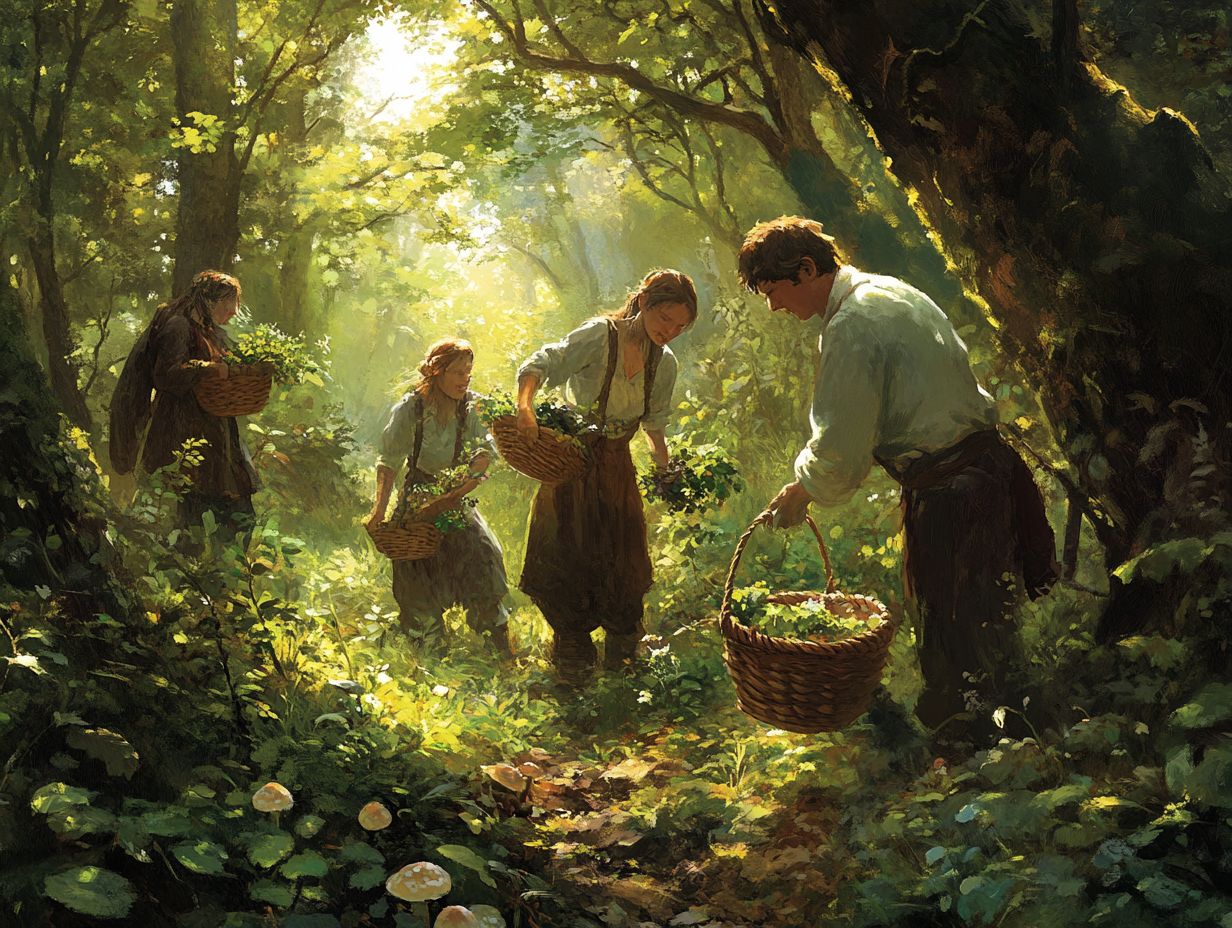
Using foraged foods in your cooking not only elevates your culinary experiences but also fosters a deeper connection with nature and the wild plants that surround us. Embracing the flavorful benefits of wild plants, including edible mushrooms and herbs, opens up a world of diverse recipes that celebrate these unique ingredients.
If you’re eager to dive into the realm of foraging, there are countless ways to weave these special ingredients into your everyday meals, from foraging tips to local herbalists recommendations. Imagine wild garlic enhancing your homemade pesto, wildcrafting some dandelion greens, or incorporating wild herbs to add a refreshing crunch to your salad instantly transforming even the simplest dishes into something extraordinary.
These wild plants not only introduce a vibrant burst of seasonal flavor but also come with health benefits, often boasting higher nutrient levels than their cultivated counterparts. This makes them a smart choice for food foraging. To embark on this journey, consider exploring foraging guides, participating in herbalism classes, or attending local workshops to ensure you gather safely and sustainably.
Whether you re whipping up a wild mushroom risotto, indulging in a berry-infused dessert, or experimenting with wildcrafting, foraged foods undoubtedly bring an exciting twist to your home cooking.
6. Recognizing Poisonous Plants
Recognizing poisonous plants is an essential skill for anyone diving into foraging. This skill helps you avoid accidental ingestion and ensures you can safely explore the rich diversity of wild foods.
Understanding the detailed descriptions and distinguishing characteristics of harmful species, along with effective plant identification techniques, significantly reduces your risk of poisoning. A common mistake is confusing edible plants like wild carrots with toxic relatives, such as poison hemlock. This emphasizes the need to take herbalism courses to improve your knowledge.
Knowing the subtle differences in leaf shape, flower structure, and growth habitats can truly be life-saving. It’s vital to be equipped with a well-stocked first aid kit and knowledge of herbal medicine, enabling a swift response in emergencies.
Bring a foraging buddy. Staying informed about local plants and practicing with knowledgeable guides will enhance your experience. For those new to the practice, it’s helpful to refer to a beginner’s guide to foraging techniques, paving the way for safe and enjoyable foraging adventures.
7. Respecting the Environment and Wildlife
Respecting the environment and wildlife is essential in foraging. This aligns with the principles of caring for the environment and sustainable harvesting.
By practicing this respect, you promote eco-conscious foraging and ensure that natural ecosystems remain healthy for future generations. This approach fosters a sense of community learning among local foraging groups.
When you follow the principles of sustainable foraging, you minimize your impact on the environment. This embodies a philosophy of leaving no trace and actively safeguarding wildlife habitats.
Community foraging groups play a vital role in this practice. They educate members about ethical collection methods and teach workshops on wildcrafting. This deepens the respect for local flora and fauna.
Through hands-on activities, these groups help you understand nature better. They foster a culture of responsibility, ensuring that foraging honors both the land and future foragers.
How Can Foraging Benefit the Environment?
Foraging enhances the environment by promoting sustainability and inviting you to connect with your local ecosystems. This fosters a deeper appreciation for biodiversity and highlights the importance of caring for the environment within your community.
As you explore foraging, discover amazing wild plants and native species that showcase the delicate balance of local habitats. These plants play a crucial role in controlling invasive species that threaten local ecosystems.
This practice encourages local biodiversity, as you and your community become more aware of your surroundings. This leads to participation in initiatives supporting sustainable harvesting techniques.
Numerous grassroots organizations offer workshops on foraging ethics and sustainable practices. Join us for guided foraging tours that teach you how to gather resources responsibly.
These communal efforts expand your knowledge and cultivate a sense of responsibility and environmental stewardship. This helps conserve natural spaces for future generations.
What Are Some Common Mistakes to Avoid When Foraging?
When foraging, it’s essential to steer clear of common mistakes like misidentifying plants and poisonous species. Neglecting safety guidelines, including the need for a first aid kit for emergencies, is also critical. To improve your skills, consider exploring the art of foraging. Additionally, overharvesting can harm local edible plants.
These blunders can transform your first foraging experience into a negative one and jeopardize the sustainability of local ecosystems. As you embark on this exciting journey, recognizing the diverse flora and their edible properties may feel overwhelming. Familiarize yourself with the specific characteristics of the plants you wish to forage. A great way to avoid misidentification is to use a field guide, identification classes, or a reliable app to double-check your findings.
Always prioritize your safety by avoiding areas that may have been treated with pesticides, which affect wild edibles. Understanding which parts of a plant are safe to consume is also important. Maintaining a sustainable and environmentally friendly approach to foraging is vital. By only harvesting what you truly need and leaving enough behind for the plants to flourish, you can protect your local environment for future generations.
What Are Some Tools and Equipment Needed for Foraging?
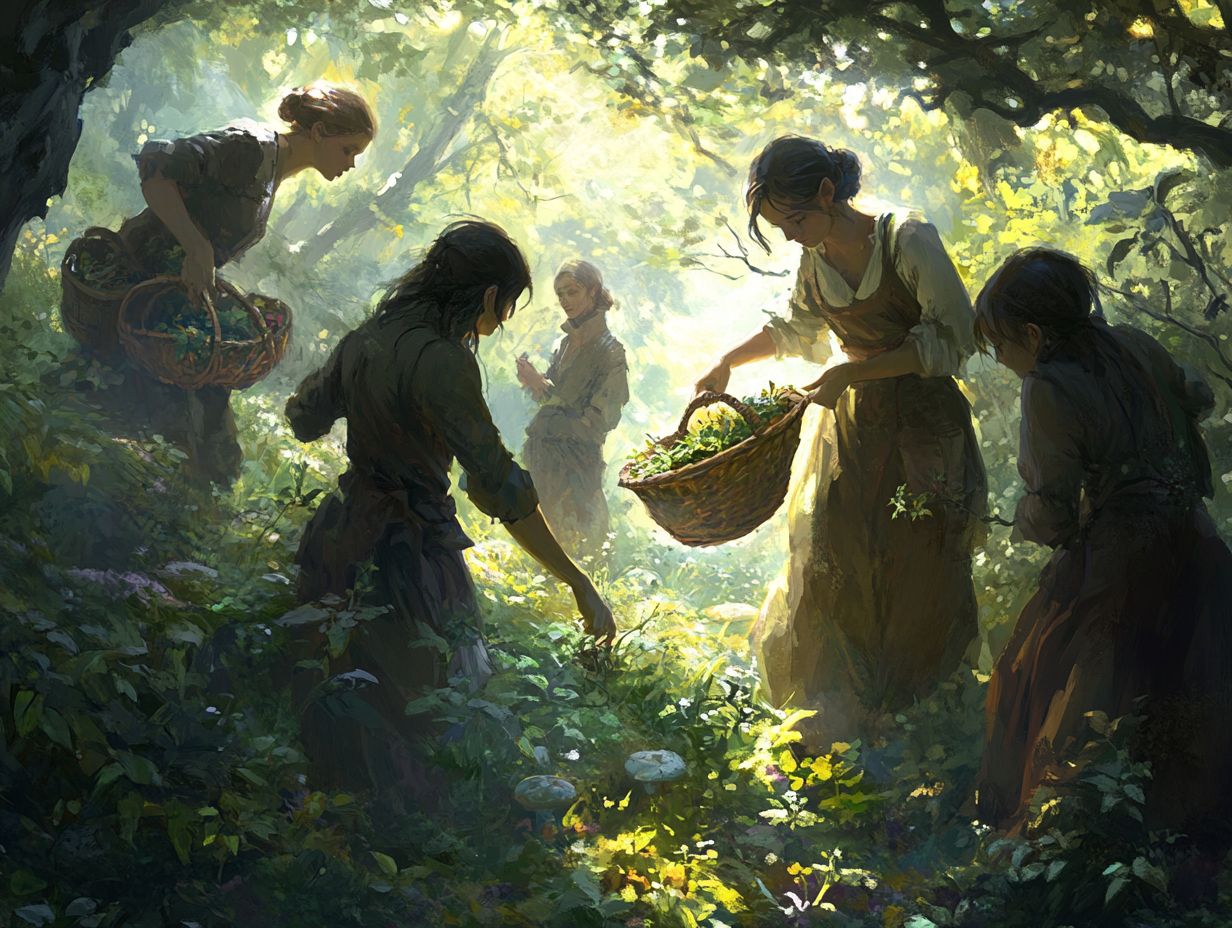
Having the right tools is essential for ensuring a successful and safe experience while enhancing your foraging skills. For more guidance, check out these top tips for successful foraging. This allows you to efficiently identify, harvest, and process wild edibles.
Key tools include:
- Sharp knives for plant processing, ensuring a clean harvest.
- Baskets for collecting wild food without causing damage.
- Gloves for handling wild mushrooms to protect your hands.
- A good field guide to help you discern between edible and toxic species.
Let s not underestimate the importance of a first aid kit; it offers peace of mind and prepares you for any mishaps that might occur in the wild. With these tools in hand, you can navigate the world of wildcrafting which means gathering plants in their natural environment with greater confidence.
How Can Foraging Be Incorporated into a Sustainable Lifestyle?
Incorporating foraging into your sustainable lifestyle allows you to connect more profoundly with nature, sourcing your own food directly from local ecosystems. This promotes eco-conscious practices while enhancing your health through natural remedies derived from wild plants.
Not only does this practice minimize the carbon footprint associated with commercial food production, but it also fosters a mindful relationship with nature. By exploring the outdoors to gather a variety of fruits, nuts, and herbs, you can cultivate a sense of community and share knowledge with like-minded individuals.
The act of foraging boosts your personal health through organic, nutrient-rich foods and strengthens social bonds that form in foraging groups. As you come together with others to learn about local flora, you create a supportive network that promotes resilience in the face of modern food challenges.
Start your foraging journey today and discover the joy of nature!
What Are Some Common Foraged Foods and Their Nutritional Benefits?
Common foraged foods like wild herbs, dandelions, and elderberries offer a remarkable array of nutritional benefits that can elevate your diet and serve as valuable allies in traditional plant-based remedies.
These foods are often brimming with essential vitamins and minerals. Take dandelion greens, for example; they re rich in Vitamin C, which can boost your immune function and help combat inflammation. Elderberries shine with their high levels of antioxidants, supporting overall health and strengthening your body s defenses against colds and the flu.
Exploring the world of wild herbs can transform your meals into gastronomic adventures! Wild herbs not only add unique flavors to your dishes but also provide anti-inflammatory properties that can aid in wellness. Embracing foraged foods goes beyond nourishment; it’s a journey that connects you to nature s bounty and the ancient wisdom of local herbalists.
How Can Foraging Connect People to Nature and Their Local Community?
Foraging creates profound connections between you, nature, and your local community. It invites you to explore the great outdoors while sharing knowledge within the wildcraft community, enhancing your connection to the environment. This experience enriches social ties and heightens environmental awareness through hands-on activities.
As you venture into local forests, meadows, or even urban landscapes alongside others, you engage in a shared experience that fosters teamwork and nurtures a sense of belonging. Group foraging outings provide an opportunity to bond over common interests while uncovering the diverse plants and mushrooms that flourish around you.
Participating in workshops can elevate this journey, offering hands-on education about sustainable foraging practices and the ecological significance of native species vital to local ecosystems. Through these enriching activities, you not only nourish your body with foraged foods but also cultivate a deeper appreciation for the intricate web of life that supports your local ecosystems.
Frequently Asked Questions
What are the 7 essential foraging skills for everyone?
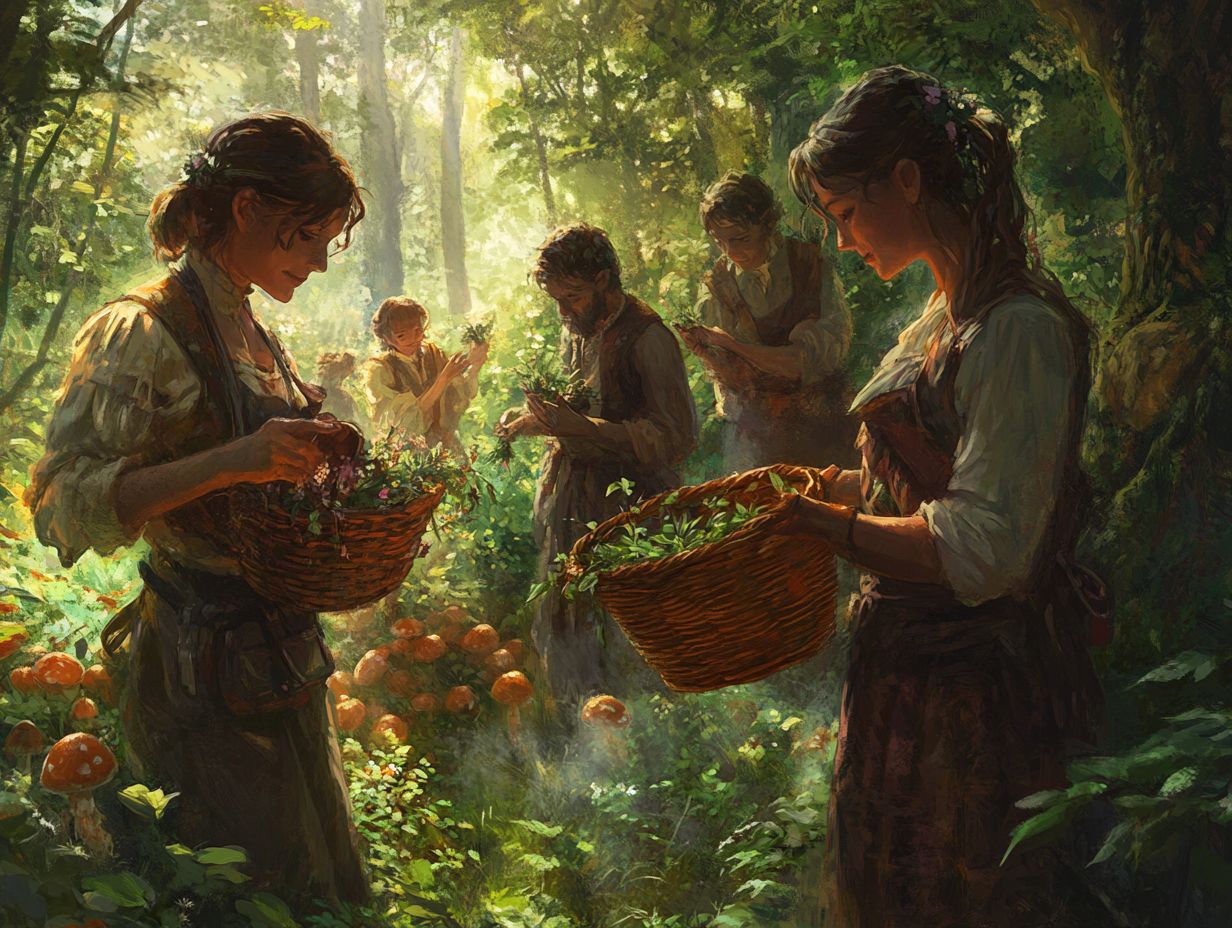
The 7 essential foraging skills for everyone are plant identification, tracking, fire building, shelter building, water sourcing, tool making, and food preservation.
Why is plant identification an important foraging skill?
Plant identification is crucial for foraging as it helps you determine which plants are edible and which are poisonous. It also allows foragers to find specific plants for their medicinal or nutritional properties.
How does tracking play a role in foraging?
Tracking is vital in foraging as it helps identify the location and movement of animals, which can lead to potential food sources. You can also learn about animal behavior and patterns, which can be useful in future foraging trips.
What is the importance of knowing how to build a fire when foraging?
Fire is essential for cooking, boiling water, and keeping warm while foraging. Knowing how to build a fire can also be useful for signaling for help in emergency situations.
Why is shelter building an important foraging skill?
Shelter building is crucial for survival in the wilderness. It provides protection from the elements and potential predators, ensuring your safety and well-being.
How does water sourcing factor into foraging?
Water is essential for survival, and knowing how to find and purify water sources is crucial. Without access to clean water, the body can quickly become dehydrated, leading to serious health issues.
Why is food preservation an essential foraging skill?
Food preservation allows you to save excess food for later use, ensuring a steady supply even in times of scarcity. It also helps prevent food waste and allows you to enjoy a variety of foods throughout the year.

